 Wall
Street, venture capitalists, technology executives – all have important
reasons to understand the growth and opportunity in the artificial
intelligence market, but the inherent vagueness of the term makes any
single valuation extremely difficult. Indeed, the term “artificial
intelligence” is notorious for having a relatively amorphous definition.
Wall
Street, venture capitalists, technology executives – all have important
reasons to understand the growth and opportunity in the artificial
intelligence market, but the inherent vagueness of the term makes any
single valuation extremely difficult. Indeed, the term “artificial
intelligence” is notorious for having a relatively amorphous definition.In order to put together an executive brief for market size and projected growth of AI, I’ve molded this article around (a) AI-related industry market research forecasts, and (b) a limited number of reputable research sources for further insight into AI valuation and forecasting, in addition to select and relevant quotes.
Bear in mind that different market research firms define “artificial intelligence” according to varying criteria. To make this summary article more useful, we’ve quickly broken down all reports by source, definition / meaning of “artificial intelligence”, valuation, and timeline.
The goal of this article is do provide a short consensus on well-researched projections of AI’s growth and market value in the coming decade, and to (as always) provide amble references for further exploration for those of you who aim to go deeper. We’ve aimed to stick to sources whose reputation rests on their objectivity, rather than on excited statements of companies whose incentive is to see the future their way (such as IBM’s CEO claiming a potential $2 trillion dollar market for “cognitive computing”).
Artificial Intelligence Market Forecasts and Valuations
(The following profiles and forecasts are updated on a quarterly basis)- Source: Forrester Research
- Definition: “Cognitive computing technologies”
- Forecast Timeline: 2020
- Market Value Projected: $1.2 tn (Global GDP annual growth rate of 3.5%)
In 2017, these technologies will increase businesses’ access to data, broaden the types of data that can be analyzed, and raise the level of sophistication of the resulting insight. In the year ahead, we expect that:
1) Investment in AI will triple
2) Big data will become the big friend of CI pros
3) Digital analytics vendors will aggressively build out IoT capabilities
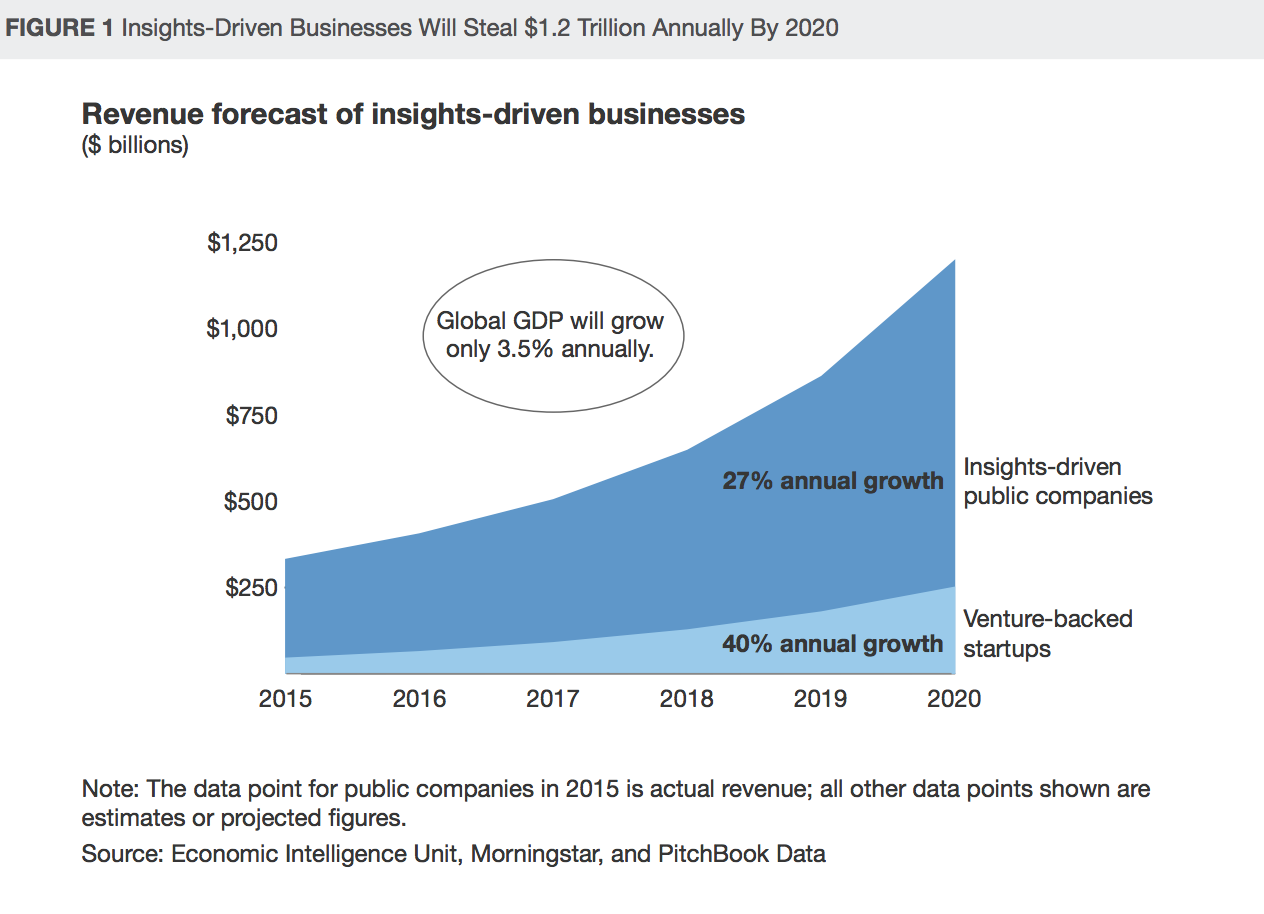
The vast majority of firms believe that having an organizational model that supports analytics is critical to breaking down the silos of customer knowledge that exist throughout the enterprise…Enterprises are starting to show signs of elevating the priority of, and investment in, initiatives to get rid of existing silos. In 2017, we expect these efforts to become major initiatives:
1) Chief data officers (CDOs) will come of age…
2) Customer data management projects will increase by 75%…
3) Leading CI practices will be the poster child for business transformation
- Source: Tractica Research
- Definition: “Tractica defines AI as an information system that is inspired by a biological system designed to give computers the human-like abilities of hearing, seeing, reasoning, and learning. AI has applications and use cases in almost every industry vertical and is considered the next big technological shift.”
- Forecast Timeline: 2025
- Market Value Projected: $36.8 bn
Tractica forecasts that the revenue generated from the direct and indirect application of AI software is estimated to grow from $643.7 million in 2016 to $36.8 billion by 2025. This represents a significant growth curve for the 9-year period with a compound annual growth rate (CAGR) of 56.8%.The chart below shows Tractica’s top 10 AI use cases in terms of revenue in 2025:
andTractica has assumed a somewhat conservative adoption of AI in the hedge fund and investment community, with an assumption that roughly 50% of the hedge fund assets traded by 2025 will be AI-driven. Even with the conservative estimate, the algorithmic trading use case remains the top use case among the 191 use cases identified by Tractica.
Out of the top 10 use cases, 60% of the use cases are related to big data and 40% are related to image or object recognition, which is a good high-level characterization of how the market is expected to shape up.
- Source: Aman Naimat, Founder of Spiderbook (in collaboration with O’Reilly)
- Definition: “Technologies available that are achieving human- or super-human-level intelligence on a given human task (aka “narrow intelligence”)”; however, Naimat also notes that “it is not the purpose of this report to argue what Artificial Intelligence is or is not’. Rather, I take a practical approach to the definition of AI and present an analysis based on self-identified businesses that claim to be using or building AI.”
- *Forecast Timeline: Less a forecast than a *data-based analysis of companies currently investing in AI-based technologies, which sheds a light on present-day trends and provides an informed jumping off point for projected forecasts.
- Market Analysis (Top 3 highest number of use cases by percentage of resources spent):
- Cyber intelligence (22%)
- Healthcare (10%)
- Manufacturing automation (8%)
There are only 1,500 companies in North America that are doing anything related to AI today, even using its narrow, task-based definition. That means less than one percent of all medium-to-large companies across all industries are adopting AI.and
A breakdown of AI adoption does not provide a fair picture of the current level of AI maturity in the market. The following two figures detail how many companies are using these AI technologies beyond lab experiments (i.e., those developing applications based on it or deploying it across the company).Spiderbook’s current data visualization of companies investing in AI:
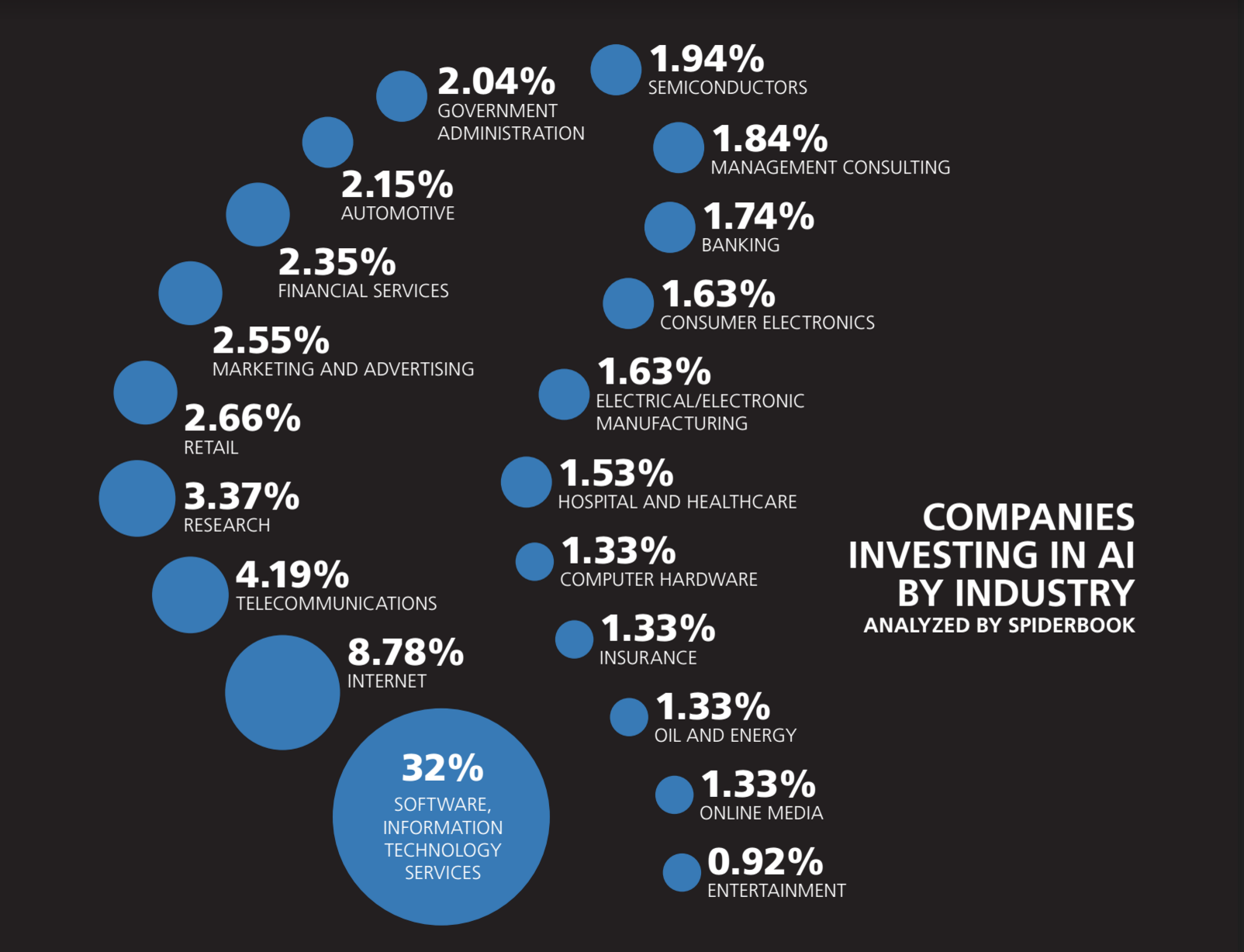
- Source: Accenture
- Definition: Artificial Intelligence (AI) refers to IT systems that sense, comprehend, act and learn.
- Forecast Timeline: 2035
- Market Value Projected: $8.3 tn (U.S. only – compared to $814 bn in UK, $2.1 tn in Japan, and $1.1 tn in Germany, all measured in GVA i.e. gross value added)
Select quotes:
While the gains vary from country to country, our results are indicative of AI’s ability to transcend regional and structural disparities, enabling huge, rapid leaps in labor productivity.and
To fulfill the promise of AI as a new factor of production that can reignite economic growth, relevant stakeholders must be thoroughly prepared—intellectually, technologically, politically, ethically, socially—to address the challenges that arise as artificial intelligence becomes more integrated in our lives. The starting point is understanding the complexity of the issues.Accenture’s stacked column chart of GVA growth for 12 selected countries with AI as factor in production:
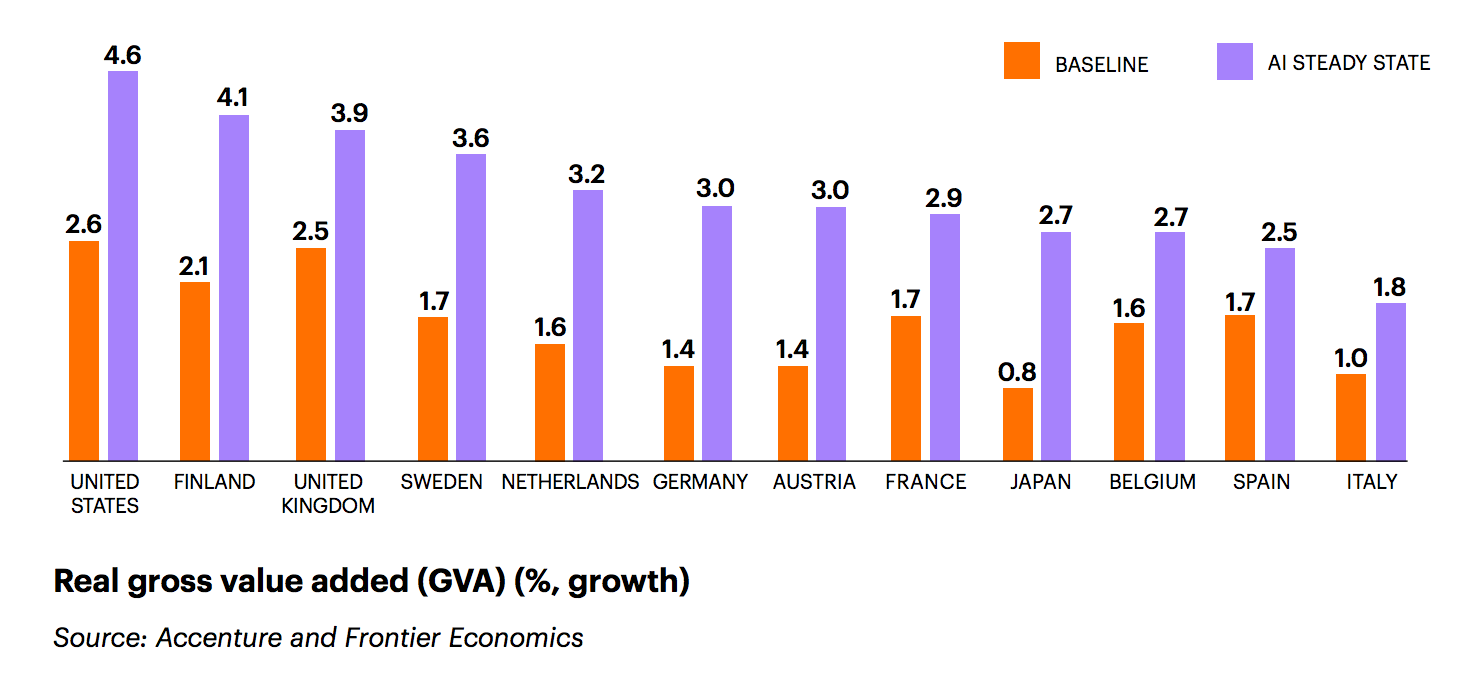
- Source: Bank of America Merrill Lynch (as covered in FT.com)
- Definition: Vaguely defined in FT’s report brief as “artificial intelligence-based systems”
- Forecast Timeline: 2020
- Market Value Projected: $70 bn
BofA Merrill reckons the market will blossom to $153bn over the next five years — $83bn for robots, and $70bn for artificial intelligence-based systems. That compares to roughly $58bn in 2014, according to a calculation by Beijia Ma, one of the report’s authors…and
Demand is expected to be driven by an ageing global population and a rise in wages of workers in emerging markets. Wage growth among China’s factory workers, for example, has surged nine-fold since 2000.BofA’s graphic representation of 12 areas of AI and robotics application, as featured on FT:
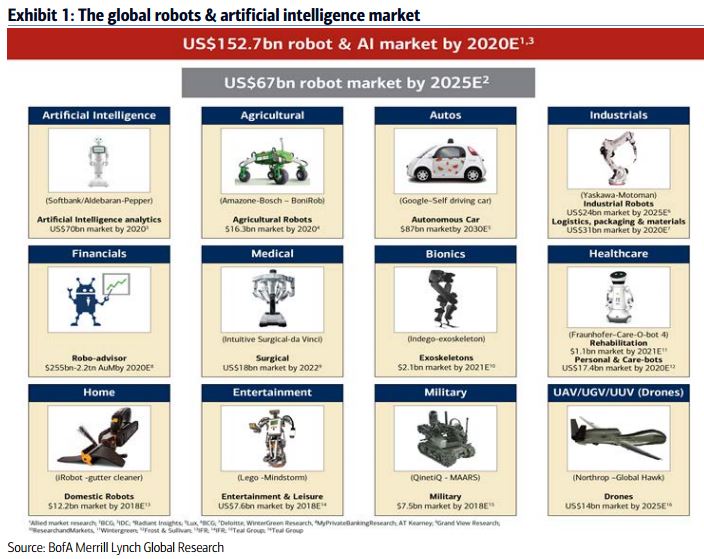
- Source: BCC Research, as presented in a lengthly article on Siemens website
- Definition: Broadly defined as “smart machines”, includes:
- Virtual reality assistants (e.g., Siri)
- Intelligent agents (e.g., automated online assistants)
- Expert systems (e.g., medical decision support systems, smart grid)
- Embedded software (machine monitoring and control systems)
- Autonomous robots (including self-driving vehicles)
- Purpose-built smart machines (such as neural computers)
- Forecast Timeline: 2024
- Market Value Projected: $41.22 bn
The global market for smart machines was valued at $5.3 billion in 2013. This market is expected to increase to over $6.2 billion in 2014 and nearly $15.3 billion in 2019, a compound annual growth rate (CAGR) of 19.7% for the five-year period 2014 to 2019…and
Expert systems (e.g. medical decision support systems and smart grids) made up the largest share of the market in 2013, followed by autonomous robots. BCC Research expects the autonomous robot category to account for the largest share — 22.8 percent — of annual market growth until 2024 and thus to dominate the smart machine market.Below is the graphic displayed on Siemens blog:
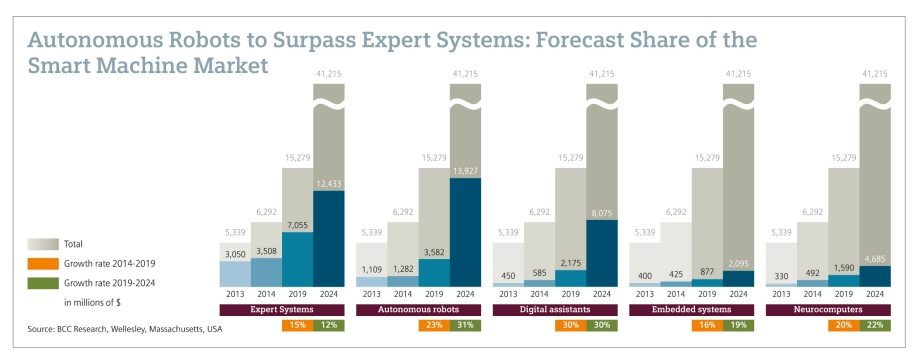
- Source: GII Research (based in Japan), as listed on one of their own report briefs
- Definition: Broadly defined, seems to refer to the entire application area of AI “by Technology (Machine Learning, Natural Language Processing, Image Processing, and Speech Recognition), Application (Advertising & Media, Finance, Retail)”
- Forecast Timeline: 2020
- Market Value Projected: $5.05 bn
The artificial intelligence market is estimated to grow from USD 419.7 million in 2014 to USD 5.05 billion by 2020, at a CAGR of 53.65% from 2015 to 2020. This growth can be attributed to the factors such as diversified application areas, improved productivity, and increased customer satisfaction.
- Source: Tractica Research
- Definition: Broadly defined in the report as follows, “The technologies covered include cognitive computing, deep learning, machine learning, predictive APIs, natural language processing, image recognition, and speech recognition”
- Forecast Timeline: 2024
- Market Value Projected: $11.1 bn
According to a new report from Tractica, the market for enterprise AI systems will increase from $202.5 million in 2015 to $11.1 billion by 2024.The graphic below is found in the aforementioned research brief:
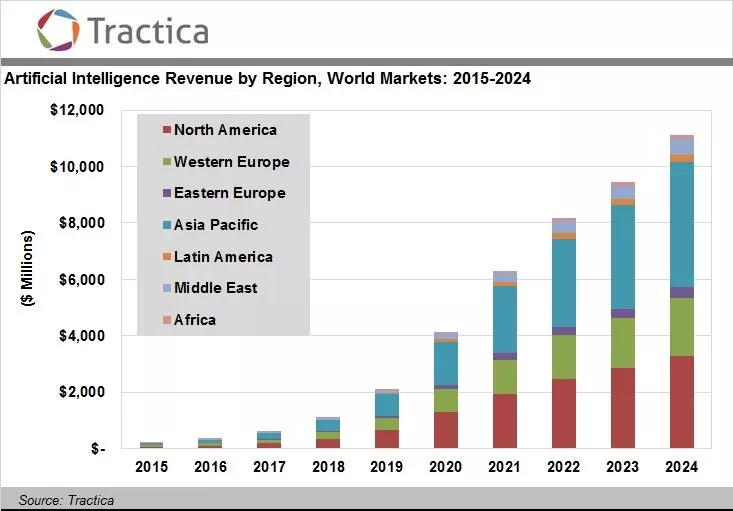
Related Market Forecasts and Valuations (Big Data and Predictive Analytics)
- Source: Wikibon research as covered by KDNuggets.com
- Definition: Big Data-related hardware, software and professional services
- Forecast Timeline: 2020
- Market Value Projected: $61.16 bn
Select quotes:
For the calendar year 2014, the Big Data market – as measured by revenue associated with the sale of Big Data-related hardware, software and professional services – reached $27.36 billion, up from $19.6 billion in 2013. While growing significantly faster than other enterprise IT markets, the Big Data market’s overall growth rate slowed year-over-year from 60% in 2013 to 40% in 2014.and
Wikibon expects the Big Data market to top $61 billion in 2020, a 26% compound annual growth rate for 2011-2020. After initial intense growth, Big Data market growth will slow considerably. This growth pattern is common to disruptive technology markets as they mature.Big data graphic as displayed on the KDN blog:
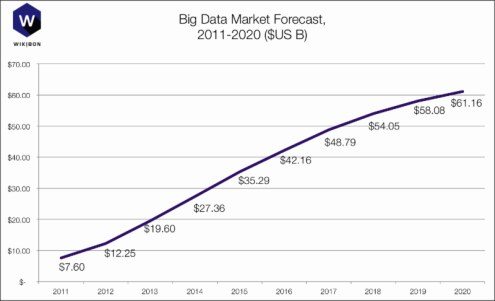
- Source: A.T. Kearney, as reported from DealFlow.com’s blog
- Definition: “Software, hardware and services” for big data
- (NOTE: This report is based on the related domain of “big data”, and wasn’t created explicitly to size the “artificial intelligence” field)
- Forecast Timeline: 2018
- Market Value Projected: $114 bn
According to a report from A.T. Kearney, the overall big data spend could grow at a 30% CAGR through 2018. The size of this market, inclusive of software, hardware and services, is projected to reach $114 billion in 2018. “The average business expects to spend $8 million on big data-related initiatives this year,” according to the Kearney report, which also says each IT job created in the process of upgrading will create three additional jobs outside IT.
- Source: Markets and Markets Research
- Definition: “Risk management, sales and marketing management, operations management, workforce management, network management, supply chain management, and other applications” for predictive analytics
- Forecast Timeline: 2020
- Market Value Projected: $9.2 bn
Select quotes:
…the global predictive analytics market to grow from USD 2.74 Billion in 2015 to USD 9.20 Billion by 2020, at a Compound Annual Growth Rate (CAGR) of 27.4% during the forecast period. The predictive analytics market is growing rapidly because of the transformation from traditional Business Intelligence (BI) techniques to advanced analytics techniques and massive surge of structured and unstructured data.
Additional AI Forecasting and Trend Resources
- Forbes, 2015 big data trends and predictions
The big data and analytics market will reach $125 billion worldwide in 2015, according to IDC. Both IDC and The International Institute of Analytics (IIA) discussed their big data and analytics predictions for 2015 in separate webcasts yesterday.
- Forbes, 2016 big data trends and predictions
IIA predicts that automated data curation and management will free up analysts and data scientists to do more of the work they want to do. Forrester says that in 2016, machine learning will begin to replace manual data wrangling and data governance dirty work, and vendors will market these solutions as a way to make data ingestion, preparation, and discovery quicker. Through 2020, according to IDC, spending on self-service visual discovery and data preparation tools will grow 2.5x faster than traditional IT-controlled tools for similar functionality.
- IDC, worldwide big data and analytics predictions, 2016
Prediction 2: By 2020, 50% of All Business Analytics Software Will Incorporate Prescriptive Analytics Built On Cognitive Computing Functionality…
Prediction 6: Through 2020, Spending on Self-Service Visual Discovery and Data Preparation Market Will Grow 2.5x Faster Than Traditional IT-Controlled Tools for Similar Functionality…
Prediction 10: Organizations That Analyze All Relevant Data and Deliver Actionable Information Will Achieve Extra $430 Billion in Productivity Gains Over Their Less Analytically Oriented Peers by 2020
- Markets and Markets Research via PR Newswire, cognitive computing 2014-2019
MarketsandMarkets.com forecasts the Cognitive Computing Market to grow from $2,510.4 Million in 2014 to$12,550.2 Million by 2019. This represents a Compound Annual Growth Rate (CAGR) of 38.0% from 2014 to 2019.
- Gartner Identifies the Top 10 Strategic Technology Trends for 2016
Advanced Machine Learning
In advanced machine learning, deep neural nets (DNNs) move beyond classic computing and information management to create systems that can autonomously learn to perceive the world, on their own.
Autonomous Agents and Things
Machine learning gives rise to a spectrum of smart machine implementations — including robots, autonomous vehicles, virtual personal assistants (VPAs) and smart advisors — that act in an autonomous (or at least semiautonomous) manner.
- Gartner Reveals Top Predictions for IT Organizations and Users for 2016 and Beyond
1) By 2018, 20 percent of business content will be authored by machines. Technologies with the ability to proactively assemble and deliver information through automated composition engines are fostering a movement from human- to machine-generated business content…2) By 2018, six billion connected things will be requesting support. In the era of digital business, when physical and digital lines are increasingly blurred, enterprises will need to begin viewing things as customers of services — and to treat them accordingly…3) By 2020, autonomous software agents outside of human control will participate in five percent of all economic transactions. Algorithmically driven agents are already participating in our economy. However, while these agents are automated, they are not fully autonomous, because they are directly tethered to a robust collection of mechanisms controlled by humans — in the domains of our corporate, legal, economic and fiduciary systems…4) By 2018, more than 3 million workers globally will be supervised by a “robo-boss.” Robo-bosses will increasingly make decisions that previously could only have been made by human managers…
5) By year-end 2018, 20 percent of smart buildings will have suffered from digital vandalism. Inadequate perimeter security will increasingly result in smart buildings being vulnerable to attack..
6) By 2018, 45 percent of the fastest-growing companies will have fewer employees than instances of smart machines. Gartner believes the initial group of companies that will leverage smart machine technologies most rapidly and effectively will be startups and other newer companies…
Conclusion
Prognostication – no matter how well informed – is risky business, especially in a field rife with buzzwords and sparse in concrete definitions. What fraction of spending on “big data” will imply the use of machine learning or other AI applications? What portion of “predictive analytics” inherently implies training AI algorithms, as opposed to merely permitting clearer forecasting and visualization? It’s hard to tell.Nonetheless, we’re of the belief that varied perspective is useful, and this summary article was intended to do jus that.
If any conclusion can be drawn, it’s likely to be the fact that the terms and applications that define the “artificial intelligence” field are grey, and that definitions must be taken on a case-by-case basis.
We might imagine that like other nascent technology fields, artificial intelligence will mature to the point of having a more robust and clear vendor ecosystem, and more defined terms to delineate between applications and uses. There are likely to be leaps and bounds in the next decade in gleaning insights from “unstructured data”, while applying predictive analytics and building business models is a more oft-used approach to implementing machine learning and data mining technologies at present.
For now, if an executive or investor has interest in a particular domain or use of artificial intelligence, the first step in determining valuation and forecast would be to draw a proverbial “dotted line” around what “artificial intelligence” means for your purposes, and to draw the varied sources to get a mosaic of where things stand in your niche.
For further exploration of the science and applications of machine learning, consider listening to some of our recent AI researcher interviews.
[This article has been updated as of February 28, 2017 to reflect new research and industry progress in the artificial intelligence market.]
Image credits: s456.photobucket.com/
Aucun commentaire:
Enregistrer un commentaire